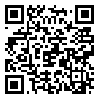BibTeX | RIS | EndNote | Medlars | ProCite | Reference Manager | RefWorks
Send citation to:
URL: http://jrh.mazums.ac.ir/article-1-89-en.html

 , Nafise Hekmati Pour *
, Nafise Hekmati Pour * 
 , Samira Khandousti
, Samira Khandousti 
 , Jamile Mirzaali
, Jamile Mirzaali 
 , Golbahar Akhondzadeh
, Golbahar Akhondzadeh 
 , Fateme Kolangi
, Fateme Kolangi 
 , Nahid Mozafari Nia
, Nahid Mozafari Nia 

Background and Purpose: Cancer is one of the worst human experiences. This condition could lead to serious crises in one’s life. Religious beliefs are of great value among patients suffering from different conditions. Among religious and spiritual resources, prayer is regarded as the most commonly applied practice. In fact, prayer as the most powerful resource for resolving problems can release spiritual energy. The present study was performed to determine the dimensions of prayer in cancer patients, referring to the food and drug center of Golestan University of Medical Sciences in 2013.
Materials and Methods: In this descriptive, correlational study, 96 cancer patients under treatment with agonist drugs, referring to the food and drug center of Golestan University of Medical Sciences, were assessed. Data were collected, using a demographic questionnaire and the prayer questionnaire by Paloma and Pendleton. For statistical analysis, descriptive (e.g., frequency, mean, and standard deviation) and inferential statistics (ANOVA) were calculated, using SPSS version 16.
Results: Based on the findings, the mean score of prayer frequency was 91.7±21.7, the mean score of prior prayer experience was 45.6±9.8, and the mean score of attitude towards prayer was 33.9±8.0. The statistical analysis showed a significant difference among the dimensions of prayer. There was a significant correlation between prayer frequency and prior experience of prayer (P<0.01), prayer frequency and attitude towards prayer (P<0.005), and previous experience of prayer and attitude towards prayer (P<0.01). However, multiple linear regression analysis did not show a significant association between the dimensions of prayer and demographic characteristics.
Conclusion: Considering the positive effects of prayer, we can conclude that this practice plays a strong supporting role in life and promotes ones’ adjustment with the side-effects of diseases such as cancer. Therefore, nurses, as the most important members of healthcare teams, can enhance care provision for cancer patients by recognizing the psychological dimensions.
| Rights and permissions | |
 |
This work is licensed under a Creative Commons Attribution-NonCommercial 4.0 International License. |



